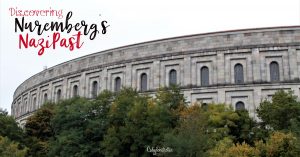
Most visitors to Nuremberg come for the beautiful historic city center loaded with bustling squares, canals and churches, the Kaiserburg castle perched on a hill overlooking the dog and most importantly, the Nuremberger sausages. Or they come for the greatest Christmas market in Germany! But not long ago, Nuremberg held a more sinister role in Germany’s history and there is so much more history beneath the surface of the city.
Fascinated by WWII history? PIN IT FOR LATER!!
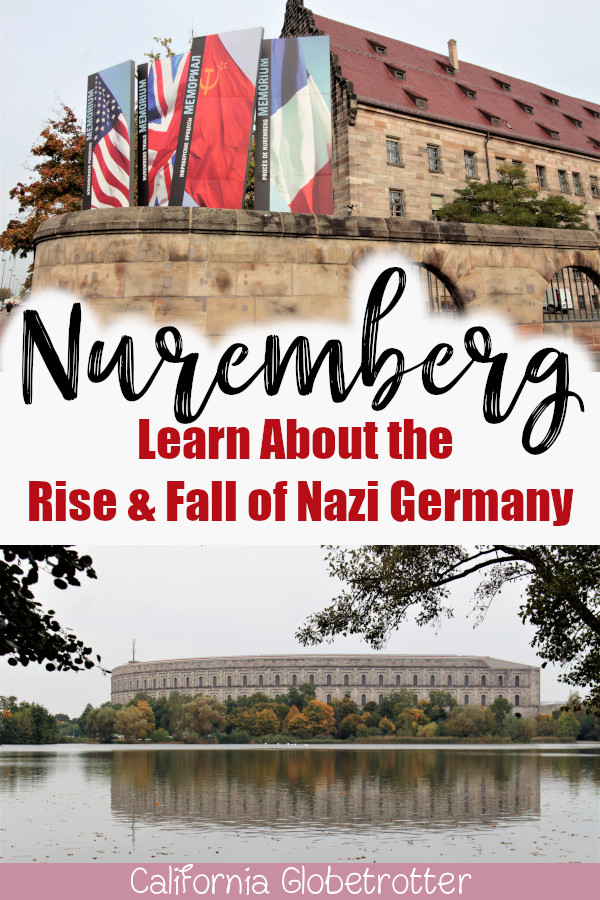
This article is now available as a mobile app. Go to GPSMyCity to download the app for GPS-assisted travel directions to the attractions featured in this article!
How to AVOID Looking Like a Tourist in Europe
If you paid attention in your history class in high school, you probably remember learning that the Nuremberg Trials were held here after the defeat of Nazi Germany. High ranking Nazi officials were held on trial here for their crimes against humanity. It was no coincidence that the trials were held here, but as a matter of significance. Nuremberg played an important role in the rise and fall of Nazi Germany,3 and what you probably didn’t realize was that Nuremberg was once the “Stadt der Reichsparteiage” (City of Party Rallies) and to hold the trials here to demand justice for those who perished under this regime only seemed fitting.
Why was Nuremberg so important to the Third Reich?
Nuremberg was important to the Nazi’s for multiple reasons. First of all, the city held historical importance as it was once the “unofficial” seat of the Holy Roman Empire and the city prospered from being quite a central location within Germany. Hitler was obsessed with racial ideology and regarded the Germanic peoples of Europe and being racially superior and envisioned an empire as great as the Holy Roman Empire. For this reason, Nuremberg was chosen as a central point for Nazi party conventions. Perhaps you’ve seen old black and white videos of mass rallies with torch bearing Nazi members and alarming speeches made by Hitler. These were used as a form of propaganda and became a symbol of the hatred and evil that spewed out of the party. Therefore, between 1933 and 1938, Nuremberg was a breeding ground within the Nazi Germany, recruiting loyal followers to do the dirty work.
The Nazi Rally Grounds
It comes as no surprise that Nuremberg has struggled with how best to cope with its dark past. While throughout Germany, anything related to the Nazi empire was destroyed for fear of becoming a Neo-Nazi rally point, much of Nuremberg’s dark history still remains.
Crumbling and falling to pieces, the massive Nazi Rally grounds have been left abandoned by the city, unsure of what to do with it. Destroy it and wipe away the past? Or turn it into a museum to teach future generations not to repeat history?
Zeppelin Fields
We began our hunt for understanding at the Zeppelin Field, so named after the Zeppelin which landed here in 1909. The fields also include a zoo, swimming pool, exhibition, Congress Hall, a lake as well as a stadium which on this day eerily echoed with cheers of joy which rumbled in the distance, reminding me of a similar sound of chants (although negative) which once emanated from here.
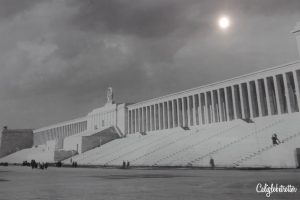
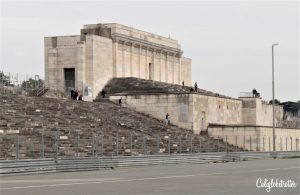
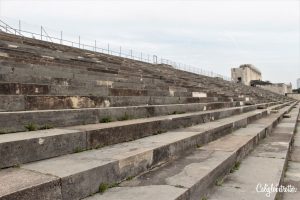 The Zeppelin Field is today an eerily imposing structure, the remnants of the past. A large cement stadium, where Hitler would give his raging speeches from his grandstand, with his highest ranking officials sat on on either side of him, who peered out into the crowd to lower members of the party on the field. The field itself is larger that 12 football fields which one can only imagine how many Nazi party members stood in perfect unison absorbing every words Hitler spewed. The whole idea was to make each person feel small and emasculated in the presence of greatness, to be a part of something larger than themselves. It gave me the shivers to know that I was standing where Hitler once stood.
The Zeppelin Field is today an eerily imposing structure, the remnants of the past. A large cement stadium, where Hitler would give his raging speeches from his grandstand, with his highest ranking officials sat on on either side of him, who peered out into the crowd to lower members of the party on the field. The field itself is larger that 12 football fields which one can only imagine how many Nazi party members stood in perfect unison absorbing every words Hitler spewed. The whole idea was to make each person feel small and emasculated in the presence of greatness, to be a part of something larger than themselves. It gave me the shivers to know that I was standing where Hitler once stood.
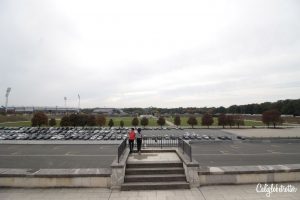
Between 1933 and 1938, six Nazi rallies were held here and in 1938, the “Cathedral of Light“ took place here and large floodlights beamed into the sky. It has been said the lights could be seen as far as Prague which was seen in the 1937 propaganda film.
Upon the victory of the allies, the US troops celebrated by blowing up the massive swastika which once topped the grandstand. Afterwards, the grounds were simply abandoned and left to fall into ruin and used as storage for the Nuremberg Christmas Market until it was finally decided to preserve these last remaining WWII relics, not out of commemoration but so that future generations can learn from the past.
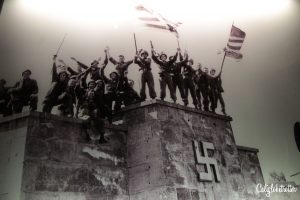
Today, the field is falling into ruin, despite 100,000 € being spent on it each year to maintain it. The structure has become so dilapidated that the safety of visitors can no longer be guaranteed without extra reinforcement, fences, nets and barriers. The structure has been known to host concerts and even drag racing.
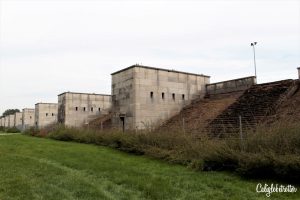
Walking Along the “Great Street”
The grounds were designed by Albert Speer, Hitler’s chief architect, 1,500 meters long by 60 meters wide “Great Street” (Große Straße) which aligns perfectly from the Nazi Party Rally Grounds to the Nuremberg Castle. Large granite slabs stretch as far as the eye can see and symbolically glorified the past imperial days of Germany to the desires of the Third Reich, lined with tall, imposing towers which portrayed an image of importance and power.
The road stretches from the Congress Hall to the Märzfeld and was never used as a parade road. After the war, the US Army used it as an airfield, however, it is more commonly used as a parking area during festival season.
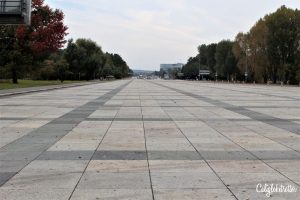
German Stadium
The Congress Hall
After walking along the Great Street, passing the lake (Großer Dutzendteich) of which you’ll catch a glimpse of the a larger than life structure known as the Congress Hall (Kongresshalle). Also purposely left in ruins, it is yet another stark reminder of Nuremberg’s Nazi past. A testament to Hitler’s megalomaniac personality, this was to be the grand stage Hitler intended to give a speech once a year to some 50,000 people, however, it was never completed but you can certainly try to imagine how small one might have felt here. If you watch Man in the High Castle, you’ll have seen the People’s Hall in Berlin which would have held up to 180,000 people in Season 2, Episode 18 “Loose Lips”.
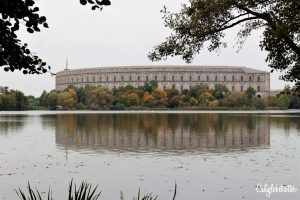
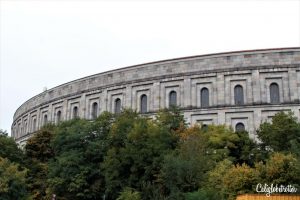
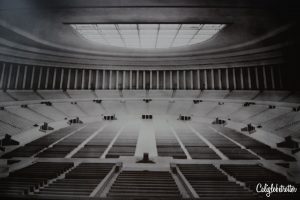 Today, the unfinished Congress Hall has been partially incorporated into the Documentation Center with a permanent exhibition on the Nazi Party’s rise and fall and is today one of TripAdvisor’s #1 rated things to do in Nuremberg!
Today, the unfinished Congress Hall has been partially incorporated into the Documentation Center with a permanent exhibition on the Nazi Party’s rise and fall and is today one of TripAdvisor’s #1 rated things to do in Nuremberg!
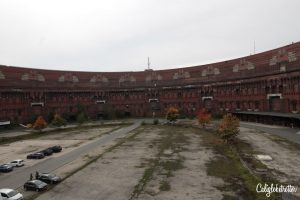
The museum showcases an exhibition on how Hitler wished to be portrayed and how he came to be the undisputed “Führer” (leader), the important that architecture played within the Third Reich, how large numbers of people quickly fell under his spell and believed and implemented his ideals and finally concluding in an estimation of how many people were systematically murdered for being Jewish, homosexual, Communist, Romani, ethnic Poles and even people who were political prisoners or had disabilities.
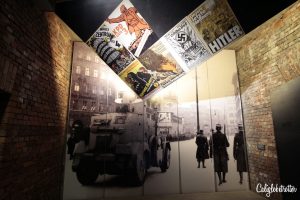
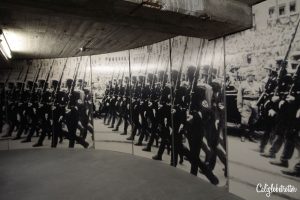
It’s worth visiting the Documentation Center to truly get an understanding of how someone like Hitler could become the almighty Dictator and how people fell under his spell. The “Faszination und Gewalt” (Fascination and Terror) exhibit showcases in chronological order how the Nazi ideology became so popular through modern marketing and media at the time which also showcases how critics and political opponents were quickly shut down and eliminated. They were sent to the Dachau Concentration Camp which was opened shortly after Hitler became Reichskanzler (chancellor).
Entry to the museum is 5 € per person which includes an audio guide in English and other languages. However, if you plan to visit at least one other museum in Nuremberg that day, I suggest getting the day pass museum ticket for 7.50 € which allows entry to both. Trust me, you will want this, especially if you’re interested in visiting the courthouse where the Nuremberg Trials were held!
The Nuremberg Trials Courthouse
Across town, we next visited the Nuremberg Palace of Justice, where after the defeat of the Third Reich justice was given. For the first time in history, top military officials and Nazi leaders were held responsible for the crimes they committed during the war at what would become known as the World Criminal Court. Today, you can visit Courtroom 600 where the highest ranking officials in the Nazi Party had to answer for their crimes before the International Military Tribunal which lasted from November 20, 1945 to October 1, 1946.
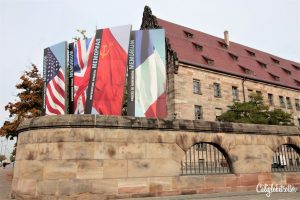
Robert H. Jackson, who served as an Associate Justice on the U.S. Supreme Court, was appointed by President Harry S. Truman as the U.S. Chief of Counsel to prosecute Nazi war criminals. He was responsible for helping to draft the London Charter of the International Military Tribunal which was the foundation of the Nuremberg Trials.

In all, 8 judges, two from each of the allied countries (US, Great Britain, France and Russia) were tasked with condemning 12 high ranking officials to death by hanging for crimes committed during the Holocaust. The crimes were divided into the following four categories: war crimes, crimes against humanity, and participating or planning crimes against peace. Three of the highest ranking Nazi officials committed suicide to avoid paying for their crimes: Adolf Hitler, Heinrich Himmler and Joseph Goebbels.
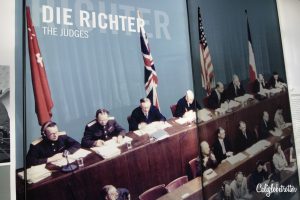
The trials had enormous influence of the development of international criminal law which is still in effect today. To this day, Courtroom 600 is still a working courtroom, however, visiting is still possible as long as the room is not being used. The recently opened museum provides enlightens visitors about the defendants and which of the crimes they were changed with as well as the impact the trials have had.
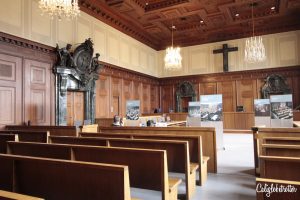
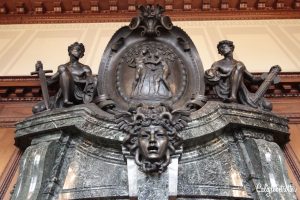
Opening Hours and Admission fees
How to get here: For the easiest way to get to/from the Documentation Center to the Nuremberg Palace of Justice, we took Bus 65 from Nürnberg Doku-Zentrum to Röthenbach (5 stations) and get off at Nürnberg Frankenstr. and take the Underground U1 to Hardhöhe (8 stations), for a total of around 17 minutes +/-.
Coming to Terms with the Past
To fully understand the events of the Second World War, it’s important to understand the significance of Nuremberg’s role in it all. I highly recommend visiting all of the sights in order to truly comprehend the rise and fall of the Third Reich. Germany has been burdened by coming to terms with their unfortunate past and have had to make up for the wrong that happened. Germany and especially Nuremberg, have done a magnificent job of not just remembering the past and honoring the victims, but also explaining the history in the hopes of educating future generations. It’s important to learn from the past to avoid making the same mistake twice. We owe it not just to ourselves and to future generations to understand how evil can spread if we’re not careful by remembering those terrible years and those who perished under the Nazi regime.
Some generations might prefer to forget the past and not think of it while younger generations might even feel like they are obligated to carry the weight of shame for what was done 70 years ago. We are not responsible for what happened then, but we are certainly responsible for what happens tomorrow.
“Those who forget history are condemned to repeat it” – George Santayana
If you’re interested in visiting Germany and are looking for more information, I highly recommend using the DK Eyewitness Travel Guide! Without these guides, I would be lost! This is my travel Bible!
 |  |  |  |
Disclaimer: This post contains affiliate links. If you click on one and make a purchase, I might make a little extra spending money, at no extra cost to you. As always, all opinions are my own and these products/services have been found useful during our travels and come highly recommended to you from yours truly!
Other Related Posts:
Liked this post? PIN IT FOR LATER!!
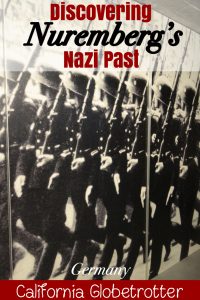
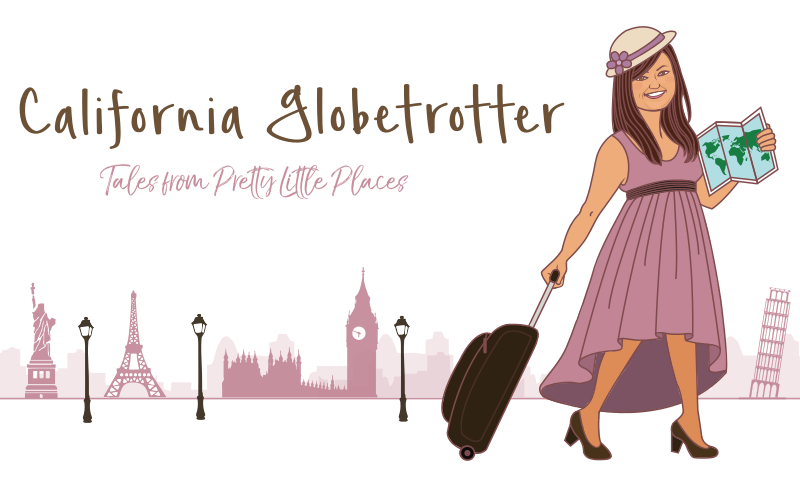




You are totally right. We are responsible for what happens tomorrow. It’s important we don’t forget what happened in the past or we will repeat the same mistakes. History is full of interesting stories, but it’s also all about understanding how we got where we are, so we need to look at the bad stuff too.
#CityTripping
I have yet to visit Nuremberg, but woud really like to. I guess seeing these sights would be really high up my list. Unmissable if you want to understand anything about European history.
#CityTripping
The Zeppelin Field sounds really eerie! I’m really interested in Germany’s history, and need to see more of it – so far, I’ve only visited Berlin and Hamburg – Nuremberg sounds like there’s a lot to learn there! #citytripping
Could have spent the entire day learning about this part of history, but I think about 4-6 hours is enough!
I think it is so important to learn about history, no matter how hard or tragic it is. I’m actually fascinated by WWII history, despite all of the tragic, ugly, heartbreaking things that happened. #CityTripping
A very well written post. It s very important to remember the past and learn not to repeat and you rightly said we owe it the next generation. I was very overwhelmed at the Holocaust museum in Washington DC. Thank you very much for this post. #citytripping
What a great and informative post! It’s so important to be educated about WWII for something like this to never happen again! Also the Zeppelin Field looks really impressive!
Such an interested and powerful post, Lorelei. It is so important to never forget the past, especially the darkest parts.
Thank you Sarah! It’s always important to continue to teach history!
Wow so much history in that one city… an entire country really. When I think of Nuremberg, I think of Christmas markets and fun charming architecture but that city is also full of history that we cannot forget.
That’s very much one thing most people connect with Nuremberg but have forgotten or don’t know the past!
It is a difficult balance between marking the horrors of the past in some way to remember and ensure they never happen again, and drawing the wrong attention to these terrible acts. It sounds like Nuremburg has worked hard to do the former and deal with its own dark past. Thanks for linking up with #citytripping
Wow, this was such an interesting and informative post. I totally get feeling super strange stranding where Hitler once stood. I’ve never done that but I imagine it’s such a crazy feeling. My fiance would find this place so interesting – he is beyond obsessed with Zeppelins & blimps. Thanks so much for sharing your visit and insight!
Wow, this was such an interesting post. I know it was a dark time in our past, but I do love history and can imagine how interesting it would have been to visit these places. I learnt a lot reading this – thank you! #citytripping
This is such a well-written, informative post. I agree. It is so important that we are reminded of the past, and that we try and grasp how a person such as Hitler could become such a powerful man. It’s an uncomfortable thinking space to be in, but only by understanding how the atrocities of the past happened, we have a chance to stop it from happening again.
Only as long as people read the history book! I’ve honestly heard people ask “What’s the holocaust?” 🙁
We lived so close to Nuremberg, and yet only visited for the fun side of things. We didn’t ever see this side. We visited a lot of dark stuff in Berlin from that terrible terrible time. I wish I had seen more here now. #citytripping
Oh that’s a shame! It was incredibly interesting!
Visiting these places is never easy, but it’s so important to keep the past alive, even when it’s not pleasant. #citytripping
I think they are right to get rid of most of it. But I also think they are right to have kept this around. Difficult to know what to do after that, so I can see why it’s falling down slowly too. That’s probably the right way for it to go.
Now I really regret not visiting more historical/political places in Nuremberg. I just went to the Nuremberg Palace of Justice but never really ventured beyond that! Thanks for such a great and informative post! 🙂
Oh that’s a shame! Hope you can return one day! The history is really fascinating!
I agree, that though WWII represented one of the darkest eras in history that unfortunately you can’t erase the committed atrocities, and we need to remember them so nothing like that happens again. Well done.
Such an informative post — pinned and saved! We went to Nuremberg once and went to the Documentation Center but not all of the other WWII sites. It’s such charming place now, rebuilt after the extensive bombing. Still, reminders of the past are all around the city, and we do well to visit and never forget…
it’s very important not to forget the past and to accept it so we can all move forward #theweeklypostcard
A sombre part of of history and one we must never forget. I hadn’t realised how much remains of this dark period in the city’s history. Thank you for sharing such a comprehensive guide and for hosting #weeklypostcard
I found Nuremberg equally haunting and quiet as though the city knows what atrocities occurred in the rise of the “perfect Germany city.” I learned a lot in the Documentation Center as well, and it helped me better understand how this could happen… and it’s made me hyper vigilant to paying attention to what is going on in the US. I was in Nuremburg in 2004, which was when things were getting a little hairy in the name of a post 9/11 world, and the lessons I learned during that time have stayed with me since. Since the 2016 election, I find myself reflecting on those lessons more frequently.
I agree it is important to learn about the past, I do worry that it will repeat itself. I want to visit all these sites when I make it to Nuremberg, so I will definitely get the museum pass – thanks for the tip. #TheWeeklyPostcard
What a great post! Sadly, the schools I attended while growing up did not teach a lot of what it is considered (or was at that time) modern history. We got a lot of Latin American, Carribean and Spanish history. Most of what I have learned about World War II has been through my travels. Nuremberg is a great place to learn more about this chapter in history. Hope to visit one day. After visiting Krakow, I understood how we all have a responsibility in trying to make the world a better place (starting by trying to be better ourselves). #TheWeeklyPostcard
How interesting to learn that about you! So people from that region didn’t help fight in the war?
For some reason, I have a fascination with everything related to World War II history. It was a very sad chapter in the history of humankind. I’ve read a lot about the Nuremberg trial and also watched some great movies about it. Coming to terms with the past hard. #TheWeeklyPostcard
I also am very fascinated by both WWI and II. We can learn so much from the past!
What a series of sights to really make you think. Thanks for sharing all of this, I had no idea about some of the details – not least how/why Nuremburg was chosen. I do think it’s important to visit places like this, whilst it’s not necessarily the kind of fun activity a lot of people think of when they want to visit Germany, I think it’s great that the country has made such an example of its past so that we can all try and make sure it doesn’t happen again. It’s not an easy line to walk but it sounds like they’ve made a great job of it.
As much as it hurts, kudos to present Germany and Nuremberg city to preserve history to teach the current and future generations not to repeat this ghastly part of history. I cannot fathom till this day how Hitler captivated the peoples to his ideology – will definitely visit the museum and the courthouse if I travel to Nurember. #TheWeeklyPostcard
People were scared and they wanted changed and he promised that and so they elected him. Kind of like what we’re seeing with Trump.
It’s becoming more important than ever for us all to understand Nazism history, given the number of far right world leaders we have at the moment. #Theweeklypostcard
What an interesting and moving post. Your final paragraph is beautifully written. I certainly would not fancy going to a concert at the Zeppelin Field.
Totally agree with you; history and remnants of the past must be preserved so that future generations can learn from them and hopefully not make the same mistakes. As someone who has always been fascinated by WW2 history, this made a fascinating read. Thanks for sharing. #WanderfulWednesday
I had no idea about the Zeppelin Field! Need to share your post with my boyfriend. He’s a historian specializing in WWII and he’d totally want to go to Nuremberg after reading this 😉
Glad to introduce you! I bet your boyfriend knows about it then, but he would definitely love all the history!
How fascinating, I didn’t realise that the buildings were still standing
You’re right, I didn’t know the link between Nuremberg and the Nazi history. It sounds like you learnt a lot here! And I couldn’t agree more with your sentiment that we are responsible for what happens tomorrow.
It is so important that we remember the past to avoid such atrocities happening in the future, and posts such as this remind us of that. I did not know of Nuremberg’s significance so thank you for this education. I wrote my own post about Auschwitz so have delved into this dark subject. Pinned so others may visit when they are in Germany. #feetdotravel
This post is rather close to my heart, because (without going into much detail) I wouldn’t have been born if it wouldn’t have been for WW2. My family was very much hurt under the war. I feel it like my personal task to bring the stories from that particular past to future generations. I am planning a trip to Munich this spring and will definitely go on a third reich tour. If I ever make it to Nurnberg, I’d really look into this too.
#FeetDoTravel
Wow what an inspiring story, despite the circumstances!